THE RED AND THE BLACK
THE RED AND THE BLACK
AMERICAN FILM NOIR IN THE 1950S
ROBERT MIKLITSCH
2017 by the Board of Trustees
of the University of Illinois
All rights reserved
1 2 3 4 5 C P 5 4 3 2 1
 This book is printed on acid-free paper.
This book is printed on acid-free paper.
Library of Congress Cataloging-in-Publication Data
Names: Miklitsch, Robert, 1953- author.
Title: The red and the black : American film noir in the 1950s / Robert Miklitsch.
Description: Urbana : University of Illinois Press, 2016. | Includes bibliographical references and index.
Identifiers: LCCN 2016026159 (print) | LCCN 2016042419 (ebook) | ISBN 9780252040689 (hardback) | ISBN 9780252082191 (paperback) | ISBN 9780252099120 (e-book)
Subjects: LCSH : Film noirUnited StatesHistory and criticism. | BISAC: PERFORMING ARTS / Film & Video / History & Criticism. | PERFORMING ARTS / Film & Video / Direction & Production. | HISTORY / Social History.
Classification: LCC PN 1995.9. F 54 M 545 2016 (print) | LCC PN 1995.9.f54 (ebook) | DDC 791.43/6556dc23
LC record available at https://lccn.loc.gov/2016026159
For Red Badge Detective readers everywhere and for my mother, Catherine B. Miklitsch (19252016), a native of Niagara Falls, who instilled in me an appreciation, deep as life itself, of poetry and the love that moves the sun and all the stars
But the problem of film criticism, like art criticism, arises because it is a genre which does not exist in its own right. All great art critics have been poets.
Jean-Luc Godard
I see a red door and I want it painted black
No colors anymore, I want them to turn black
Paint It Black, Rolling Stones (Mick Jagger and Keith Richards, 1966)
CONTENTS
ACKNOWLEDGMENTS
I want to begin by expressing my gratitude to Danny Nasset for his early enthusiasm for this book. Hes a prince of an editor and prescient to boot. In addition, I want to thank all the staff at the University of Illinois Pressespecially Angela Burton, Marika Christofides, Kevin Cunningham, Tad Ringo, and Roberta Sparenbergfor shepherding The Red and the Black through the publication process and beyond. Their labor is anything but invisible to this writer.
Im also grateful to Daryl Malarry Davidson, a devotee of 50s American cinema, who was gracious enough to proofread the manuscript before it was submitted to the press, and to Jill R. Hughes, who was incredibly clement about my jazz-fueled queries about how far I could push house style and grammatical etiquette. Listening to early Blue Note Miles Davis while reviewing the copy may not have been the wisest decision, but, needless to say, all the blue notes are mine. Im beholden, in addition, to Evan Shaw, award-winning documentary filmmaker at WOUB, for taking time out of his busy schedule to make 4K images for me, and Sheila Bodell, for compiling the index and graciously agreeing to defer payment.
Thanks to the marketing and publicity department at Illinois, Im pleased to be able to give a shout-out here to the Mystery Writers of America for nominating my previous Illinois book, Kiss the Blood Off My Hands: On Classic Noir, for an Edgar Allan Poe Award and to the American Library Association for naming it a Choice Outstanding Academic Title of 2015.
collaborated at these journals, Sharon Willis and Stephen Tropiano. Id also like to tip my fedora to Felicia Campbell at the Popular Culture Review and James Distefano at the Journal of Popular Film and Television.
In the course of writing this book, Ive tried to review the extant criticism on 1950s noir and am therefore indebted to all of the writers whom I cite. In addition to Mark Osteen, whose essay on nuclear noir provided a template for my own take on the subject, I want to single out Jeff Smith, who, unbeknownst to me, was writing about anticommunist noirin particular, The Woman on Pier 13around the same time that I was. I was therefore both surprised and delighted to discover how fraternal our readings are, which not only confirmed my considered sense of these red films but, happily, that the act of interpretation is less subjective than it is sometimes made out to be.
At Ohio University, Brian McCarthy, associate dean of the College of Arts and Sciences, has generously provided funds for the index, and the Research Support Fund has been instrumental in acquiring illustrations. In the English department, Sherrie Gradin has been a wonderfully supportive chair; the faculty, unfailingly collegial colleagues; and the students in my film noir class, Kiss Me Deadly, spirited and engaging interlocutors. Im much obliged as well to Beth Quitslund and Ghirmai Negash for their continued support of the last noir course, without which this book would certainly be poorer.
In the same spirit, I want to express my deep appreciation to Ann Douglas, whose intellectual companionship and profound knowledge of classic American noir have been a real gift. I can only hope that The Red and the Black lives up, at least in part, to her imprimatur.
Mille grazie to Hedy and Joe Ruffalo, new friends from outside of the 6, who are not only super, salt-of-the-earth people but very proud of me, like my father (another native of NF) as well as my brother and sistersCathy (Nyack, New York), Dave (Colorado Springs), Tre (Buffalo), Fran (Washington, D.C.), and Rose (Toronto/Santa Monica)who may be geographically distant from me but remain as close as a heartbeat.
Finally, Im most indebted to Jessica Jayne Burchard, whose mad lyrical skills and sing-along singing continue to amaze and delight me. Luck is not, contrary to Ian Fleming in Casino Royale (1953), a woman, but Im lucky to have her in my life. Bartender, two martinis, sil vous plat: Three measures of Gordons, one of vodka, half a measure of Kina Lillet. Shake it very well until its ice-cold, then add a large thin slice of lemon peel. Got it? (James Bond, Rouge et Noir, Casino Royale).
PRISE DE POSITION
FOR 50S NOIR, OR CONFESSIONS OF A FILM NOIR ADDICT
Our true passions are selfish.
Stendahl, The Red and the Black (1830)
Nineteen fifties noir is, like Disney noir, something of an oxymoron. The stereotypical conception of the Fiftieswhether its Elvis or Eisenhower, Lucy or Ozzie and Harriet, Chevies or gray flannel suits, Sputnik or Levittown-style suburbiajust doesnt jibe with the stereotypical notions about film noir (private eye, femme fatale, chiaroscuro, etc.).
The major premise of The Red and the Black: American Film Noir in the 1950sthat there is such a thing as 50s noir, that its not a contradiction in termsis therefore counterintuitive. More to the point, perhaps, this book sets out to disprove the received, declensionist argument about the fall of 50s noir as opposed to its rise in the 1940s. Since I am wary aboutfor, I think, good philosophical reasonsthe conventional valorization of the general over the particular (theme [+]/example []) as well as overarching arguments about both 50s and historical noir, the deconstructive thesis of The Red and the Black

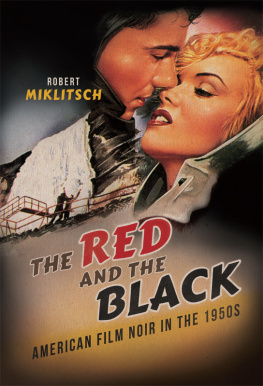
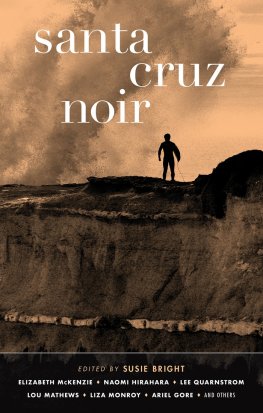

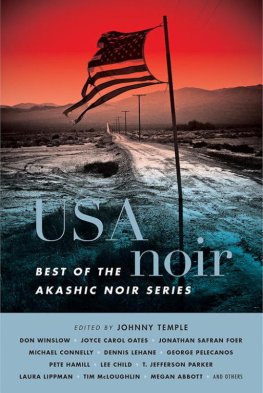



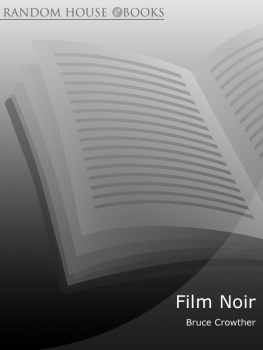

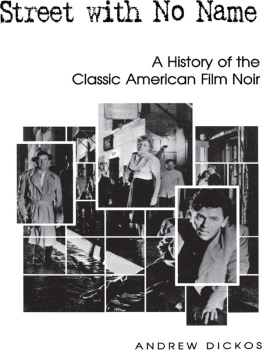





 This book is printed on acid-free paper.
This book is printed on acid-free paper.